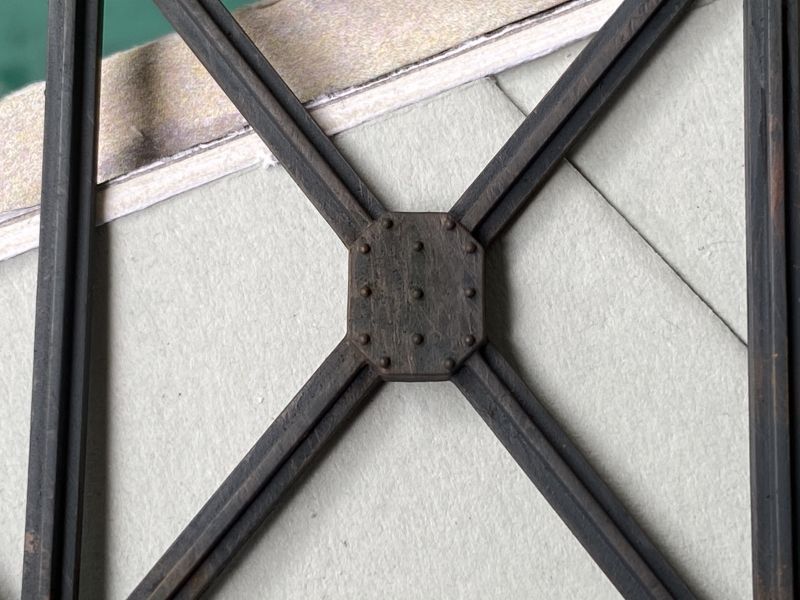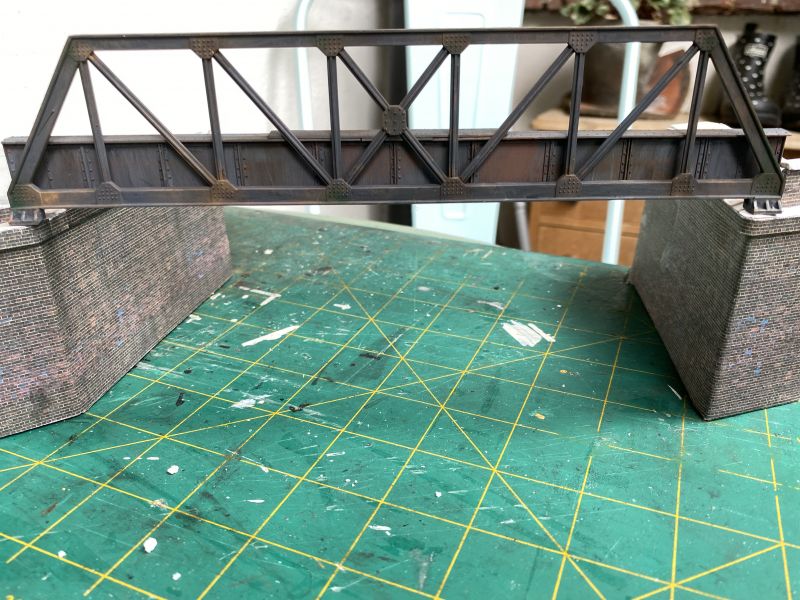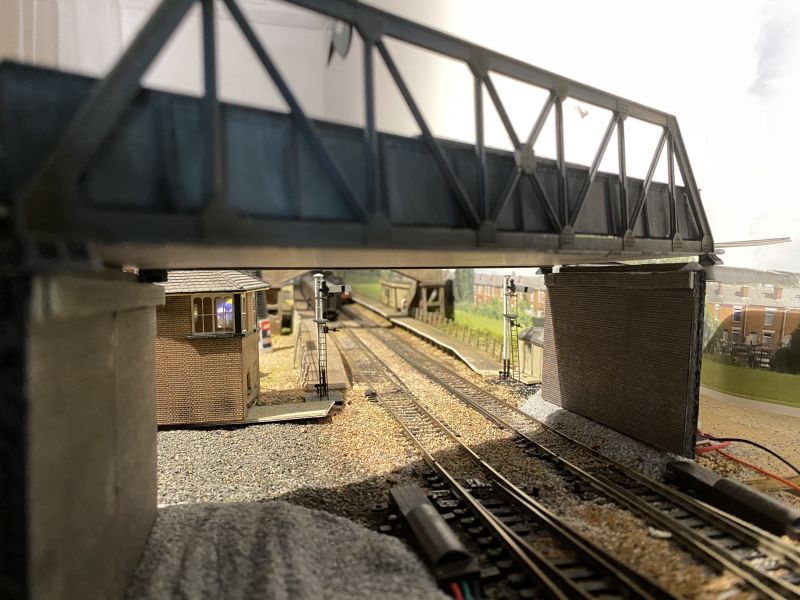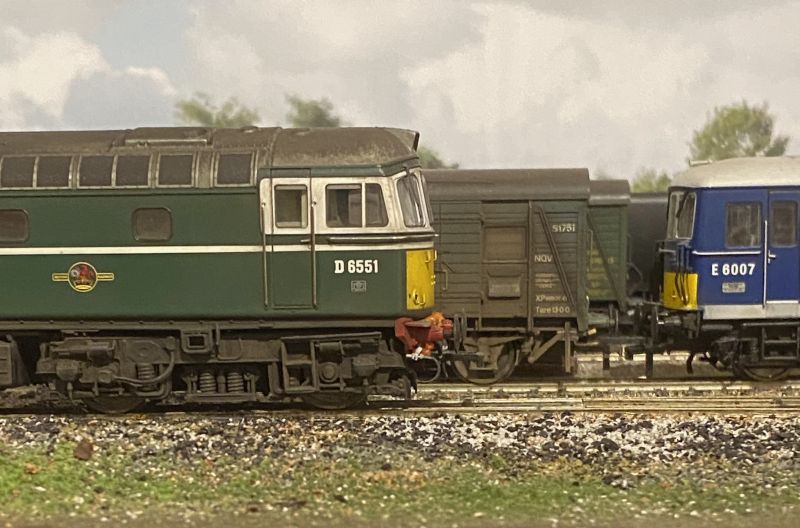Waddlemarsh
Posted
Full Member
Somewhere SW of London. Somewhen before today
More attention to the metalwork. Detailed with rust, black and dark green weathering powders which adds a patchy effect to the main girders and brings up the rivets and joints on the inner ones. And posed for a hint of the finished product.


Posted
Full Member
Jeff Lynn,
Amateur layabout, Professional Lurker, Thread hijacker extraordinaire
Amateur layabout, Professional Lurker, Thread hijacker extraordinaire
Posted
Full Member
Cheers, Andrew
:cheers
Posted
Full Member
Posted
Full Member
:pathead
Cheers,John.B.:thumbs
Posted
Full Member
The deck is 3mm foamboard topped with black card. One or other was not sufficiently robust but the two-layer construction is both light and sturdy.
A new view of the approach to Waddlemarsh Halt opens up for trains entering from the fiddle yard.


Posted
Full Member
'Petermac
Posted
Full Member
Roger OO DC Steam
Posted
Full Member
I had expected to have to spend hours checking every wire, every connection and every circuit following the last switch-on which showed a short through the CDU.
I put that off and, frankly, couldn't be faffed with it any more.
Today I was tinkering with a few bits including wiring in the last few point motors; those are the ones where I had to wait for supplies of the motors due to the pandemic shortages.
I pinned a motor to its point and was wiring back to the switch when I discovered a fully-wired motor hanging beneath the layout. I have no idea why. I don't recall leaving it there and the fact that it was fully wired suggests it should have already been attached to a point. It showed tell-tale signs of burnout; there was a dimple on the top of the plastic housing suggesting excessive heat and the sliding tie-rod wouldn't budge.
As I took the wires for the new motor back to the panel I discovered which point the rogue motor should have been fitted to; quite by chance it was the one I was working on. So I wired in the new motor and removed the rogue and its wires.
Power on. And HEY :lol: No more short. Not even a buzz! Problem solved without ever having checked a connection! :thumbs
No click and no movement from the point either but that's more than likely down to a wire having been poked too far into a choc-block somewhere and fixed by the sheath not the bare end. That should be an easy fix.
Fortune sometimes smiles :Happy
Posted
Full Member
That was indeed most fortunate. But then, don't we make our own luck? Glad it is all (almost) working perfectly.
Michael
Posted
Full Member
Now for the signals. And then the lighting.
Posted
Full Member
Step-down module required to ensure the Dapol signals receive their preferred 9V from the 12V output. Not expensive and a lot cheaper than burning out a motor and replacing a signal.
While I was at it I ordered a few spares as point motors are occasionally wont to fry when you don't have another. They never do that if you have a spare in stock! The loco-release crossover in the yard has some sort of point-motor problem which I suspect relates to the age and quality of its original wiring. The quick answer is to replace both motors with new and - on this occasion - with Peco wiring looms rather than attempt to solder connection upside-down beneath the boards.
Everything else works as it should. But I want to re-jig the track power circuitry which at present limits the operation on the passenger line to one train because it's all on one circuit. I can reconfigure that to have Up and Down tracks on separate circuits which will be easier now that some electrofrog points have been replaced with insulfrogs.
A couple of train moved up and down tonight with all points set from the panel. That's a first.
Posted
Full Member


Posted
Full Member
Michael
Posted
Full Member
All the points were wired up and working perfectly until I connected the final pair of motors which are wired to fire as master-and-slave controlling a crossover. All are wired exactly as Peco say; common power is green with control on the red and black wires. Connect the final wire (green from the crossover) and I get a short at the CDU output.
I have tried disconnecting and reconnecting all the wires in the same and in different configurations. The motors were swapped with new ones from the spares box. Doesn't matter what I do I get a short.
Disconnect the offending points and everything worked fine. Therefore it's not the CDU. Reconnect everything except the offending crossover and there's now a short once again. But this was all working a moment ago.
So I am now engaged in the tedious and time-consuming task of tracking down where the problem lies. Disconnect in turn each and every green wire at each and every connection and choc-block. Already I have eliminated around half the wiring which returns no short when reconnected.
Slowly slowly apprehend simian ………
Posted
Full Member
I’m not saying that the troubleshooting is quick or easy all the time, if find that sometimes it is and sometimes it isn’t.
It is confidence in the ability to troubleshoot that I find rewarding.
Crack on, you are doing famously!
Posted
Site staff

Don't ask me how I know…
Ron
NCE DCC ; 00 scale UK outline.
NCE DCC ; 00 scale UK outline.
Posted
Full Member
Funny you should say that, Sol, because the next day I switched on with the offending crossover still disconnected and got a short. :twisted:The worst part is, one has a short & one spends many hours looking for it & you give up & come the next day & it has vanished ….
Don't ask me how I know…
So now it's check EVERY wire and connection starting with the greens because it appears to be the common feed causing the problem. As I have things wired the single lead comes off the CDU and fans out, through a series of chock-blocks working on the one-in-two-out principle, to feed a wire to each motor.
Already half the wiring has been found to be in good order. The other half still requires checking as I track down the problem.
And if it's not in the greens then it's in the reds or blacks.
Watch this space.
Posted
Full Member
Thank you Marty.The advantage, of course, is that you have a complete understanding of what wire goes where and why and through the application of logic can be confident in your troubleshooting abilities.
I’m not saying that the troubleshooting is quick or easy all the time, if find that sometimes it is and sometimes it isn’t.
It is confidence in the ability to troubleshoot that I find rewarding.
Crack on, you are doing famously!
It's the time that is the bug-bear. And, currently, the heat. Our rather warm (by local standards) summer with days around 30C makes crawling about under the layout a bit sticky and unpleasant.
I wonder if it's tempting fate to start wiring up the signals now ….. :hmm
Posted
Full Member
I traced one short to touching wires beneath a switch. Problem sorted. Another was traced to a faulty switch but which showed initially as the same short because both switches fed to the same green wire. Replaced switch. Problem sorted.
The reluctant crossover motors also had their switch replaced (previously it had been the original switch re-wired) and that is also now problem sorted.
My stock of spare lever switches is exhausted. My points all work. At present there is no short on the layout.
Now to discover if the signals work. But that has to wait for a voltage regulator to arrive in the mail in order to be suer they receive only 9V off the 12V output. Dapol has conceded that their signal motors can burn out using 12V even though they were initially designed for that much.
1 guest and 0 members have just viewed this.

